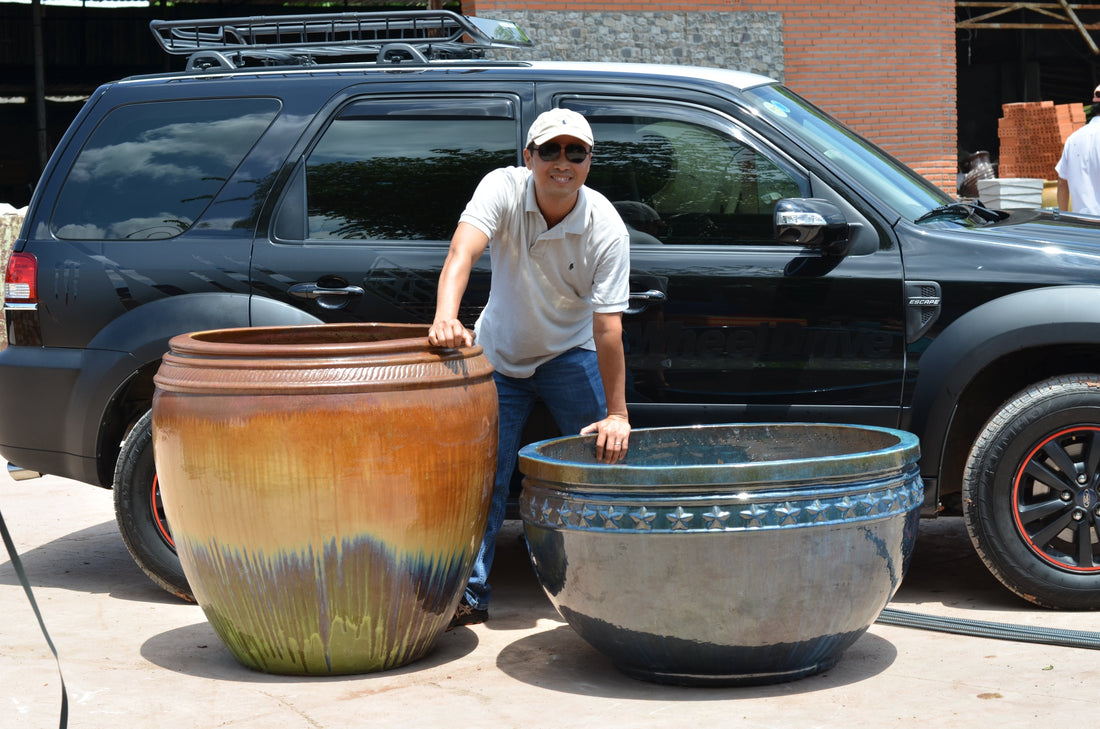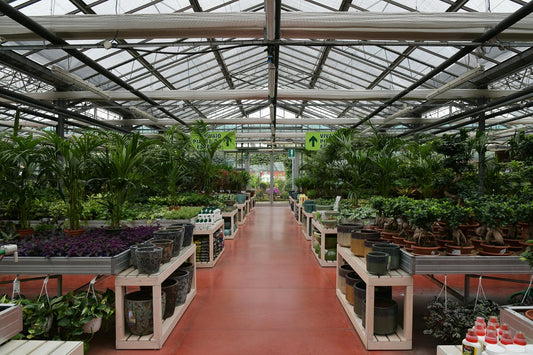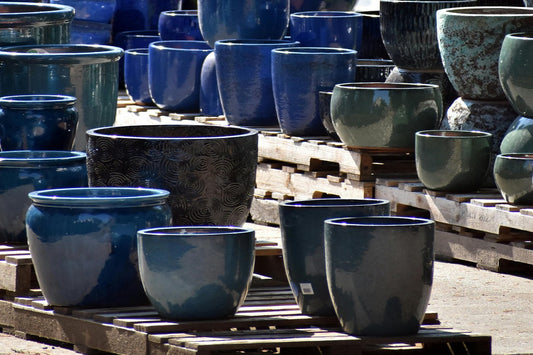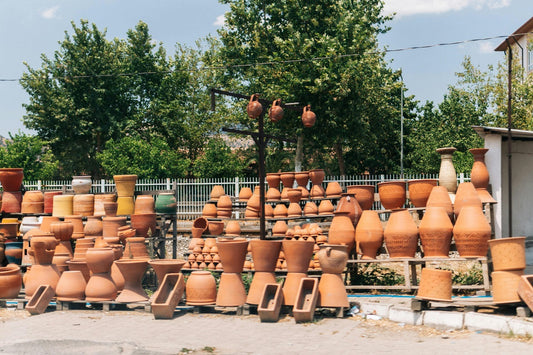
Types of Pottery Explained For Garden Centers
Share
Choosing the right type of pottery for an independent garden center is an important decision, properly aligning your inventory with buyer demand can see inventory move quickly, increasing turnover and getting profits into your pocket sooner. With pottery and planters available from around the world—from traditional Vietnamese ceramics to modern fiberglass—understanding the differences in quality, durability, and value is essential for making the best choice for your needs.
In this comprehensive guide, we'll compare pottery from major producing countries and break down popular planter materials to help you select containers that combine beauty, functionality, and lasting value.
Pottery by Country of Origin: A Global Comparison
Vietnamese Pottery: Traditional Craftsmanship Meets Durability
Vietnamese pottery stands out for its wood-fired glazed ceramic production methods that have been refined over centuries. These planters are built to last with several distinctive features:
Key Characteristics:
- Thick walls and ceramic glaze layers fired in high temperatures provide exceptional durability, each pot lasting for decades. Their sturdiness also makes Vietnamese pottery frost-proof, as long as there’s no standing water in the planter.
- Wood-fired kilns create unique, one-of-a-kind finishes with natural variations from the firing process. (Learn more about the pottery production process at TT Pottery)
- Heavy construction offers stability for large plants and windy conditions
- Slightly porous material allows roots to breathe while retaining moisture
Best For: Homeowners seeking durable outdoor planters with authentic Asian aesthetics, frost-resistant containers for year-round use, and unique statement pieces with artisan character.
Value Rating: Mid to high range with excellent longevity
Chinese Pottery: From Affordable to Heirloom Quality
China's centuries-old ceramic tradition produces an incredibly wide range of planters at every price point. Chinese pottery spans from budget-friendly mass-produced containers to durable, high-quality ceramic planters, allowing for garden centers to carry a variety of price rangers in pottery.
Key Characteristics:
- Quality varies significantly based on price and manufacturer, ranging from cheap, lower quality to premium, higher-end pottery.
- Modern production uses gas-fired kilns for consistent results
- Lots of both rustic and contemporary styles
- Options range from lightweight to very heavy depending on construction
Best For: Best for businesses with a large price range in pottery or needing mass-produced pots in a couple styles.
Value Rating: Extremely variable—from budget-friendly to premium investment pieces.
Mexican Pottery: Vibrant Colors and Rustic Charm
Mexican planters offer two distinct styles that bring warmth and character to any space:
Terra Cotta:
- Classic unglazed clay with natural breathability
- Porous material excellent for plant health but requires frequent watering
- Light to medium weight makes moving and rearranging easy
- Prone to cracking in freezing temperatures
- Highly affordable—best budget option for warm climates
- A lower firing temperature, makes pots malleable, lighter, and less durable
Talavera Ceramics:
- Hand-painted with vibrant, colorful patterns
- Traditional Mexican artisan craftsmanship
- More fragile than other glazed options
- Not frost-proof—best for indoor or warm-climate outdoor use
- Mid-range pricing for authentic pieces
Best For: Warm climate gardens, indoor plant displays, Southwestern or Mediterranean design styles, and budget-conscious plant enthusiasts.
Value Rating: Excellent for the price, especially terra cotta; expect shorter lifespan in harsh climates.
Italian Pottery: European Elegance and Premium Quality
Italian pottery represents the pinnacle of European ceramic craftsmanship, particularly from renowned regions like Tuscany and Impruneta.
Key Characteristics:
- High-fired terra cotta is similar to the Mexican terra cotta, but is fired at a higher temperature, which makes it more durable and frost resistant
- Less porous than Mexican terra cotta—retains moisture better
- Italian stoneware is heavy, but extremely durable, fit for classic European aesthetics with timeless appeal
- Premium pricing reflects superior quality and craftsmanship
- Thick walls provide insulation for roots and durability
Best For: Luxury landscapes, formal gardens, heirloom-quality investments, and those seeking authentic Mediterranean style.
Value Rating: High-end investment that delivers decades of beauty and performance.
Malaysian Pottery: Modern Production Meets Competitive Value
Malaysia has emerged as a significant player in the global planter market, offering smaller to medium sized designs at competitive prices.
Key Characteristics:
- Glazed ceramic with smooth, modern finishes
- Likely gas kiln production for consistency
- Thinner walls and lighter glaze compared to Vietnamese pottery
- Lighter weight than traditional ceramics—easier to handle
- Small to medium sizes, 24in and less, machine made
- Not good for large sizes
Best For: Modern landscapes, commercial installations, budget-conscious projects requiring durability, and tropical or resort-style aesthetics.
Value Rating: Excellent value proposition—quality construction at competitive prices.
Planter Materials: Pros, Cons, and Best Uses
Terra Cotta
Advantages:
- Naturally porous and breathable—promotes healthy root systems
- Moisture wicks through walls, preventing overwatering
- Develops beautiful patina over time
- Widely available and affordable
- Classic aesthetic suits any garden style
Disadvantages:
- Fragile—chips and cracks easily if dropped
- Not frost-proof in most cases
- Dries out quickly, requiring frequent watering
- Hard water buildup can appear on exterior
Best Applications: Indoor plants, succulents and cacti, warm climate gardens, traditional and cottage garden styles.
Glazed Ceramic: Durability Meets Design Versatility
Advantages:
- Highly durable with proper care
- Non-porous surface retains moisture longer
- Easy to clean—dirt and stains wipe away
- Available in countless colors, patterns, and finishes
- Frost-resistant when properly fired
- Large up to 50in tall, 30in wide
Disadvantages:
- Can chip if struck or dropped
- Heavier than plastic or fiberglass alternatives - can be advantage
- Less breathable than unglazed terra cotta
- Mid to high price point
Best Applications: All-climate outdoor use, home accents, low-maintenance gardens, contemporary and traditional designs.
Concrete: Industrial Strength and Modern Aesthetics
Advantages:
- Extremely heavy and stable—won't blow over in wind
- Highly durable and weather-resistant
- Modern, minimalist aesthetic
- Can last decades with minimal maintenance
- Hard to clean
- Large sizes
Disadvantages:
- Weight makes repositioning difficult
- Higher price point for quality pieces
Best Applications: Permanent outdoor installations, contemporary landscapes, rooftop gardens, commercial properties.
Fiberglass: Lightweight and Budget-Friendly
Advantages:
- Extremely lightweight—easy to move and rearrange
- Can mimic stone, ceramic, or metal appearance
- Weather-resistant and won't crack like ceramic
- Affordable, especially for large sizes
Disadvantages:
- Can look artificial upon close inspection
- Becomes brittle with prolonged sun exposure
- Less breathable than natural materials
- May fade over time
- Not environment friendly
Best Applications: Large planters where weight is a concern, temporary displays, budget-conscious projects.
Fiberstone: The Best of Both Worlds
Advantages:
- Fiberglass reinforced with crushed stone/cement
- More realistic appearance than plain fiberglass
- Lighter than concrete or stone while maintaining durability
- Weather-resistant and frost-proof
- Won't crack or chip like ceramic
Disadvantages:
- More expensive than basic fiberglass
- Still heavier than pure fiberglass options
- Limited breathability for roots
Best Applications: High-end commercial installations, luxury residential landscapes, areas requiring lightweight yet authentic appearance.
Metal Planters: Modern Style with Considerations
Advantages:
- Many types available (aluminum, steel, corten, copper, zinc)
- Contemporary and industrial aesthetics
- Corten steel allows for metal rustic style planters
- Generally lightweight compared to ceramic or concrete
- Durable, long lasting even if it corrodes
Disadvantages:
- Corrodes over time without proper treatment (except aluminum and stainless steel)
- Affected by heat—can get very hot in direct sun
- Heat transfer dries out soil faster than other materials
- May require insulation or double-potting in hot climates
Best Applications: Modern and industrial design schemes, shaded locations, climates with moderate temperatures, indoor use.
Making Your Selection: Key Factors to Consider
Climate and Weather Conditions
- Cold climates: Choose frost-resistant options like Italian terra cotta, Vietnamese pottery, or glazed ceramics
- Hot climates: Avoid metal planters in direct sun; opt for thick-walled ceramics or concrete
- Wet climates: Prioritize drainage holes and non-porous materials like glazed ceramic
Budget Considerations
- Budget-friendly: Mexican terra cotta, fiberglass, basic Chinese ceramics
- Mid-range: Vietnamese pottery, Malaysian ceramics, powder-coated metal
- Premium investment: Italian terra cotta, artisan Chinese porcelain, copper or corten steel
Time on Display
- Some colors can fade after a year of display making moving old inventory harder
- Ceramic doesn’t change over time - inflation can even increase price while keeping stock that can last decades
Design/Trends
- Buyers need to consider trends in pottery that may influence buyers
- Ceramic doesn’t go out of style, being a popular choice for centuries
Conclusion: Finding Your Perfect Planter
The ideal planter balances aesthetics, functionality, durability, and budget. Vietnamese and Italian pottery offer exceptional quality for those seeking long-lasting pottery, while Malaysian and Chinese options provide excellent value. Mexican terra cotta remains unbeatable for budget-conscious plant lovers, and modern materials like fiberstone and metal suit contemporary designs. For independent garden centers, the right kind of pottery can not only sell quicker, but also provide to customers the perfect type of outdoor decor fit for their homes.
Consider your climate, plant needs, design style, and long-term goals when making your selection. Investing in quality planters pays dividends through years of beauty and performance, while budget options can work beautifully in the right applications.
Want to learn more about what kind of pottery is best for your business? Contact John@ttpottery.com for product catalogs, pricing, production lead times, or any other inquiries!


